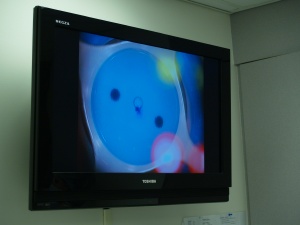Jul 7 2008
Faster recovery times and better visual outcomes are among the early results of a corneal transplant pilot study underway at the University of Michigan Kellogg Eye Center.
 Display of the femtosecond procedure. Credit: University of Michigan Health System
Display of the femtosecond procedure. Credit: University of Michigan Health System
The focus of this two-year pilot program – called the Femtosecond Laser Assisted Keratoplasty study, or FLAK – is the use of the ultrafast or femtosecond laser in performing full thickness corneal transplants.
Researchers at Kellogg were first to discover in the early 1990s that the femtosecond laser, then used for industrial purposes, had great potential for eye surgeries that traditionally required a surgical blade or knife. Through joint efforts of faculty from Kellogg and the U-M College of Engineering, the femtosecond laser was further developed, and is widely used for refractive surgery. Now, experts hope for the same success in applying this exceptionally fast and precise laser to cornea transplant surgery.
“We hope that with the use of the femtosecond laser, patients will have better vision, faster recovery of vision, and stronger wound construction, which will allow them to be more resistant to injury in the future,” says Shahzad I. Mian, M.D., assistant professor in the Department of Ophthalmology and Visual Sciences at Kellogg, and principle investigator of the FLAK study.
While lasers have been effective in eye surgeries for decades, they were not used for corneal transplants until the femtosecond laser was shown to be a superior cutting tool to the trephine, the cookie cutter-like knife currently used for transplants.
“The advantage of this laser is that it allows the surgeon to focus the laser energy at a particular depth and then rapidly cut the tissue at that depth without causing any additional injury to the surrounding tissue,” says Mian. “It also allows the surgeon to pattern these cuts into shapes – such as a mushroom, a top hat or a zig zag – that allow for better customized overlap between the donor’s corneal tissue and the patient’s corneal tissue.”
Because of the speed and precision of the femtosecond laser, the study results to date for corneal transplant surgery have been very encouraging, says Mian. If these results hold true, a larger, multi-center clinical trial comparing this procedure to the traditional method of performing transplants could follow.